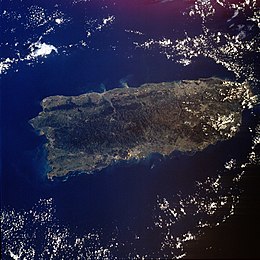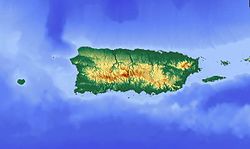
Back Xeografía de Puertu Ricu AST Γεωγραφία του Πουέρτο Ρίκο Greek Geografía de Puerto Rico Spanish Géographie de Porto Rico French Geografia di Porto Rico Italian პუერტო-რიკოს გეოგრაფია Georgian Puerto Riko geografija Lithuanian Geografia Portoryko Polish География Пуэрто-Рико Russian Географія Пуерто-Рико Ukrainian
Native name: Borinquen (Taino) Nickname: La Isla del Encanto (The Island of Enchantment) | |
|---|---|
 Satellite image of Puerto Rico | |
  Topographic image of Puerto Rico and Location of Puerto Rico within the Caribbean | |
| Geography | |
| Location | Caribbean Sea |
| Coordinates | 18°15′N 66°30′W / 18.250°N 66.500°W |
| Archipelago | Greater Antilles |
| Major islands | Spanish Virgin Islands of Vieques and Culebra Palomino Mona Monito Caja de Muertos Desecho |
| Area | 3,513 sq mi (9,100 km2) [a][1] |
| Area rank | 4th (Caribbean Islands) 81st (World Islands) 175th (World) |
| Length | 178 km (110.6 mi) |
| Width | 65 km (40.4 mi) |
| Coastline | 501 km (311.3 mi) |
| Highest elevation | 1,338 m (4390 ft) |
| Highest point | Cerro de Punta |
| Administration | |
United States | |
| Territory | Puerto Rico |
| Largest settlement | San Juan (pop. 342,259) |
| Demographics | |
| Population | 3,205,691 (2023) |
| Pop. density | 361.4/km2 (936/sq mi) |
| Ethnic groups | White 80.5%, Mulatto 10.9%, Black 8.0%, Amerindian 0.4%, Asian 0.2% |
The geography of Puerto Rico consists of an archipelago located between the North Atlantic Ocean and the Caribbean Sea, east of Hispaniola, west of the Virgin Islands, north of Venezuela, and south of the Puerto Rico Trench, the deepest point in the entire Atlantic. As the smallest and easternmost of the Greater Antilles, the main island of Puerto Rico is about 178 kilometers long (110 statute miles; 96 nautical miles) and 65 kilometers wide (40 statute miles; 35 nautical miles). With a land and internal coastal water area of 9,100 square kilometres (3,513 sq mi),[2] it is the 4th largest island in the Caribbean and 81st largest island in the world. Various smaller islands and cays, including Vieques, Culebra, Palomino, Mona, Desecheo, and Caja de Muertos, comprise the rest of the archipelago, with only Culebra and Vieques being inhabited year-round.
Larger than the state of Rhode Island but smaller than Connecticut, the main island of Puerto Rico is the 3rd largest island in the United States. Around 60% mountainous, it has three mountain ranges: Sierra Cayey in the southeast, Sierra Luquillo in the northeast, and Cordillera Central in the central and western region.[2] The highest elevation point in Puerto Rico, Cerro de Punta (4,390 feet or 1,338 meters),[3] is located in Cordillera Central, while El Yunque, one of the most popular peaks in Puerto Rico, located in the Sierra Luquillo at the El Yunque National Forest, has a maximum elevation of 3,540 feet (1,080 m).
The island has seven valleys: Caguas Valley, Yabucoa Valley, Lajas Valley, Añasco Valley, Coloso and Culebrinas Valley, River Cibuco Valley and River Guanajibo Valley, and two coastal plains: one stretching alongside the northern coast and the other alongside the southern coast. The capital, San Juan, and main metropolitan area are located on the northern costal plain in the northeast. It also has one prominent karst formation in its northwestern central region called the Northern Karst Belt, and two prominent batholiths, one in the southeast and the other in the central western region. The island has 47 major rivers and 26 reservoirs, lagoons, or lakes, among which is Laguna Grande (Big Lagoon), one of three bioluminescent bays in the archipelago of Puerto Rico located in the far northeastern town of Fajardo.[2]
Cite error: There are <ref group=lower-alpha> tags or {{efn}} templates on this page, but the references will not show without a {{reflist|group=lower-alpha}} template or {{notelist}} template (see the help page).
- ^ "State Area Measurements and Internal Point Coordinates". United States Census Bureau. Retrieved February 24, 2024.
- ^ a b c "Geografía de Puerto Rico". Sistemas de Información Geográfica (in Spanish). Retrieved February 24, 2024.
- ^ "Elevations and Distances in the United States". U.S. Geological Survey. April 29, 2005. Retrieved October 23, 2017.